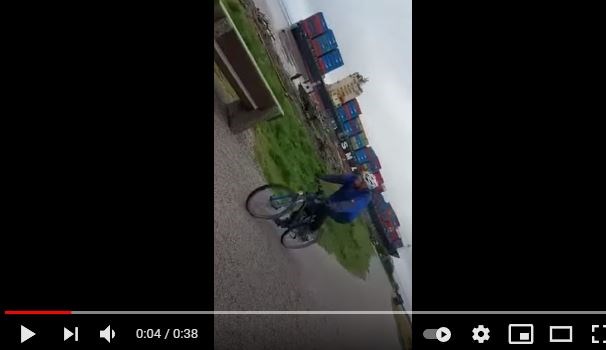The City of Richmond requested the Coast Guard ask all vessels to slow down as they near Steveston, following last week’s incident where a woman almost drowned from a freak wave at Garry Point Park.
A frightening video published by the Richmond News last Friday morning showed a surge of water – loaded with log booms and beach debris – rolling over the walking path at the park
It’s unclear what exactly caused the wave, but a container ship can be seen sailing west on the Fraser River in the background and witnesses have spoken of how it appeared to be travelling faster than ships normally do in the channel.
A woman had to be taken to hospital after the incident and the city contacted the Coast Guard to ask for a “slow bell” to be implemented for the remainder of the high tide, spring freshet season.
However, city spokesperson Clay Adams said the Coast Guard only agreed to implement the slow down warning for the remainder of last weekend.
“The city responded quickly to the incident, clearing the pathway to make it safe for users the same day,” Adams told the News.
“Rogue waves such as this are rare, so our signage in the area focuses on the more common risks associated with swimming and the strong river currents.”
Adams acknowledged the cause of the wave has not been determined, but added that “speed and proximity to shore of a large vessel may have been a major factor.”
A spokesperson for the Port of Vancouver acknowledged that the port is "responsible for ensuring the safety of the waterways within port jurisdiction, which includes this area of Fraser River."
"We recognize the seriousness of this incident and the impacts on those involved," added the spokesperson.
"We have initiated discussions with the Pacific Pilotage and other agencies to determine what factors may have led to this unfortunate event. We regularly review and update the safety practices and procedures we have set in place for vessels to follow, in particular those along the Fraser River, to highlight critical safety information and potential hazards that are unique to river waters and narrow channels."
The News has also reached out to the Coast Guard’s Marine Communications and Traffic Services division, asking if the ship in question was travelling too fast and too close to the shore and why the city's “slow bell” request was only implemented for one weekend.
The News also contacted the Transportation Safety Board (TSB), which investigates marine-related accidents and incidents.
However, a spokesperson for the TSB said the incident does not fall under its investigation umbrella.
Instead, the spokesperson cited an investigation policy, which, in summary, details how the TSB will only be called into action if the accident involves a vessel hitting something or someone, sinks or breaks down.
The News reported an eerily similar incident about a decade ago at the exact same spot in the Steveston seaside park, when a family fishing on the beach got swept up and then sucked into the river by a wave, also thought to have been caused by a passing vessel.
Thankfully, everyone survived and no one sustained serious injuries, but the exact cause was never determined.
There is a theory that displacement, caused by a large vessel’s wake, causes water to rush into the “hole” in the river, which then produces a “mini tsunami” effect when the displacement recovers, sending a large wave or surge ashore.

